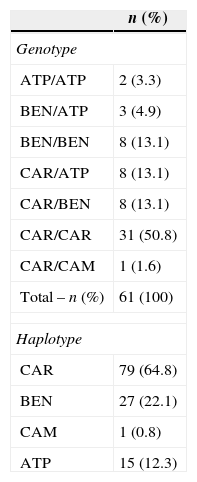Haplotypes have been useful markers for anthropological studies and to define the flow of the βS allele in human populations. They have different ethnic and geographical origins: the Central African Republic (CAR) type originated in Central southern and Eastern Africa, the Benin type originated in the central-west of African, the Senegal type is characteristic of the Atlantic coast region, the Cameroon type is found within the geographical boundaries of the country and a small part of the west coast of Africa and the Arabian-Indian or Asian type is present in the Arabian Peninsula and in India. Forms that do not correspond to the five standard types commonly associated with the βS gene are called atypical.1
Considering the incidence of sickle cell anemia this study aimed to determine the frequency of the haplotypes in the region of Uberaba.
The study sample consisted of 61 homozygous SS patients confirmed by electrophoresis.
Table 1 shows the occurrence of the genotypes and the haplotypes.
Distribution of genotypes and haplotypes.
| n (%) | |
|---|---|
| Genotype | |
| ATP/ATP | 2 (3.3) |
| BEN/ATP | 3 (4.9) |
| BEN/BEN | 8 (13.1) |
| CAR/ATP | 8 (13.1) |
| CAR/BEN | 8 (13.1) |
| CAR/CAR | 31 (50.8) |
| CAR/CAM | 1 (1.6) |
| Total – n (%) | 61 (100) |
| Haplotype | |
| CAR | 79 (64.8) |
| BEN | 27 (22.1) |
| CAM | 1 (0.8) |
| ATP | 15 (12.3) |
CAR: Central African Republic; BEN: Benin; CAM: Cameroon; ATP: atypical.
There is a clear predominance of the CAR haplotype (64.8%), compared to BEN (22.1%), ATP (12.3%) and CAM (0.8%). Findings are similar to those described in different regions of Brazil. In Ribeirão Preto (SP) there was a predominance of the CAR (66.2%) compared to the BEN haplotype (23%).2 The predominance of CAR, followed by BEN, was also observed in two other studies, with frequencies of 62.2% and 73.1% for the CAR versus 23.0% and 25.4% for BEN, respectively.3,4 In Rio de Janeiro, the CAR (54%) was more frequent than the BEN (44.6%),5 similar to what was observed in Porto Alegre,6 where the frequency was 79.6% for the CAR and 18.4% for Benin. In Pernambuco the frequency of CAR was 79.1%,7 in Rio Grande do Norte 75.5%8 and Fortaleza it was 66.2%.9 The CAM haplotype in this study showed a low rate (0.8%) similar to the rate described in Salvador (BA), Belém (PA), and Pernambuco, with frequencies of 1.2%, 1.3% and 0.8%, respectively.7,10,11
The presence of 12.3% of atypical chromosomes was similar to the occurrence observed by Silva et al. in Fortaleza.9
In relation to genotypes, the CAR/CAR predominated (50.8%), followed by CAR/ATP, CAR/BEN and BEN/BEN with a similar frequency (13.1%). These findings are consistent with those found by Cabral et al.8 in Rio Grande do Norte with 58.5% for the CAR/CAR and 16.9% for the CAR/BEN. However, our results are not similar to those described by Belisário et al.12 in Belo Horizonte, where the frequencies were 39.4% for CAR/CAR, 33.2% for CAR/BEN, 23.6% for BEN/BEN, 0.9% for CAR/ATP, 0.9% for BEN/ATP and 0.9% for BEN/Arabian-Indian. This difference might be explained by the size of the state of Minas Gerais and its territorial boundary with several other states.
This is the first study in the region of the Triangulo Mineiro, and may contribute to determining the flow of the βS-globin in the state of Minas Gerais. In addition, this study can serve as a possible tool for anthropological studies on African origin in the State and in Brazil.
Conflicts of interestThe authors declare no conflicts of interest.





